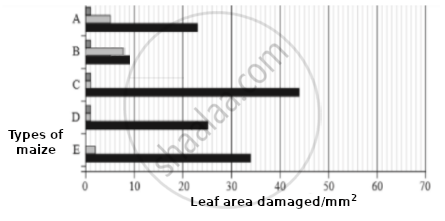Advertisements
Advertisements
प्रश्न
How did the process of RNA interference help to control the nematode from infecting the roots of tobacco plants?
उत्तर
RNA Interference (RNAi) is a gene-silencing process that blocks the expression of genes in the parasite when it enters the host's body.
-
RNAi is a method adopted to prevent infestation of roots of tobacco plants by a nematode Meloidegyne incognitia.
-
In RNAi, a complementary RNA binds to mRNA to form a ds RNA that cannot translate and hence, its expression is blocked (Silencing).
-
In this process, nematode-specific genes (DNA) are introduced in the host plant.
-
This introduced DNA forms both sense and anti-sense RNA.
-
These two strands, being complementary to each other, bend and form ds RNA, leading to RNA interference.
-
mRNA of nematode is thus silenced and the parasite cannot survive in the transgenic host.
Thus, through the above method, tobacco plants can be protected from nematode attack
APPEARS IN
संबंधित प्रश्न
What is mycoherbicide?
What is a GMO?
How has RNAi technique helped to prevent the infestation of roots in tobacco plants by a nematode Meloidegyne incognitia?
Crystals of Bt toxin produced by some bacteria do not kill the bacteria themselves because −
Answer the following question.
List one advantage and one disadvantage of an apomictic crop.
Answer the following question:
Why do farmers find the production of hybrid seeds costly?
Maize grain is a fruit known as ______.
In RNAi genes are silenced using ______.
Insects in the Lepidopteran group lay eggs on maize crops. The larvae on hatching feed on maize leaf and tender cob. In order to arrest the spread of three such Lepidopteran pests, Bt maize crops were introduced in an experimental field.
A study was carried out to see which of the three species of lepidopteran pests was most susceptible to Bt genes and its product.
The lepidopteran pests were allowed to feed on the same Bt-maize crops grown on 5 fields (A-E).
The graph below shows the leaf area damaged by these three pests after feeding on maize leaves for five days.

Key for lepidopteran insect pest species
 |
Species I |
 |
Species II |
 |
Species III |
Insect gut pH was recorded as 10, 8 and 6 respectively for Species I, II and III respectively.
(a) Evaluate the efficacy of the Bt crop on the feeding habits of the three species of stem borer and suggest which species is least susceptible to Bt toxin.
(b) Which species is most susceptible to Bt-maize, and explain why?
(c) Using the given information, suggest why a similar effect was not seen in the three insect species.
"RNA interference has been used to produce transgenic tobacco plants to protect them from the infestation by specific nematodes." Explain the novel strategy exploited by the biotechnologists.
